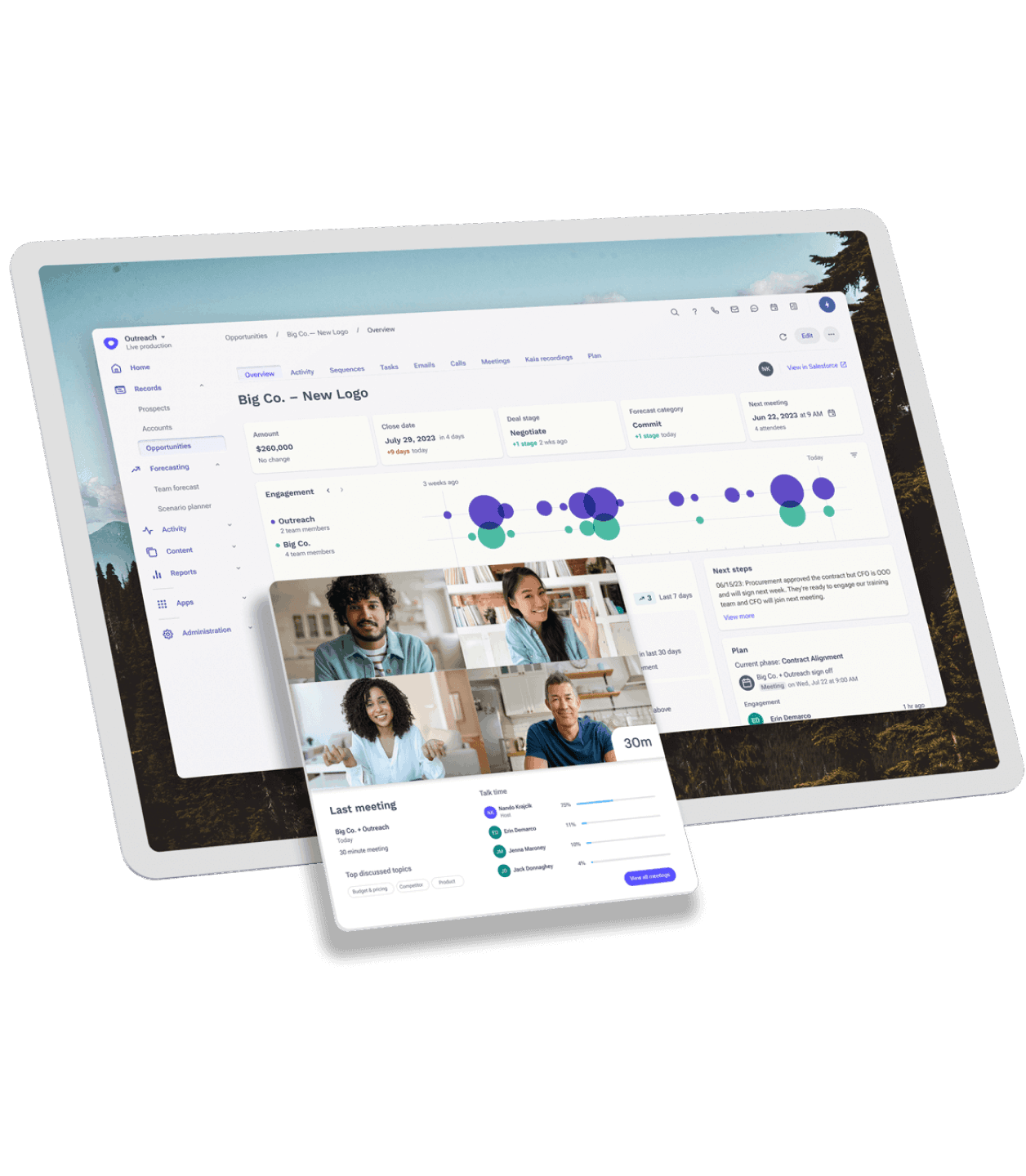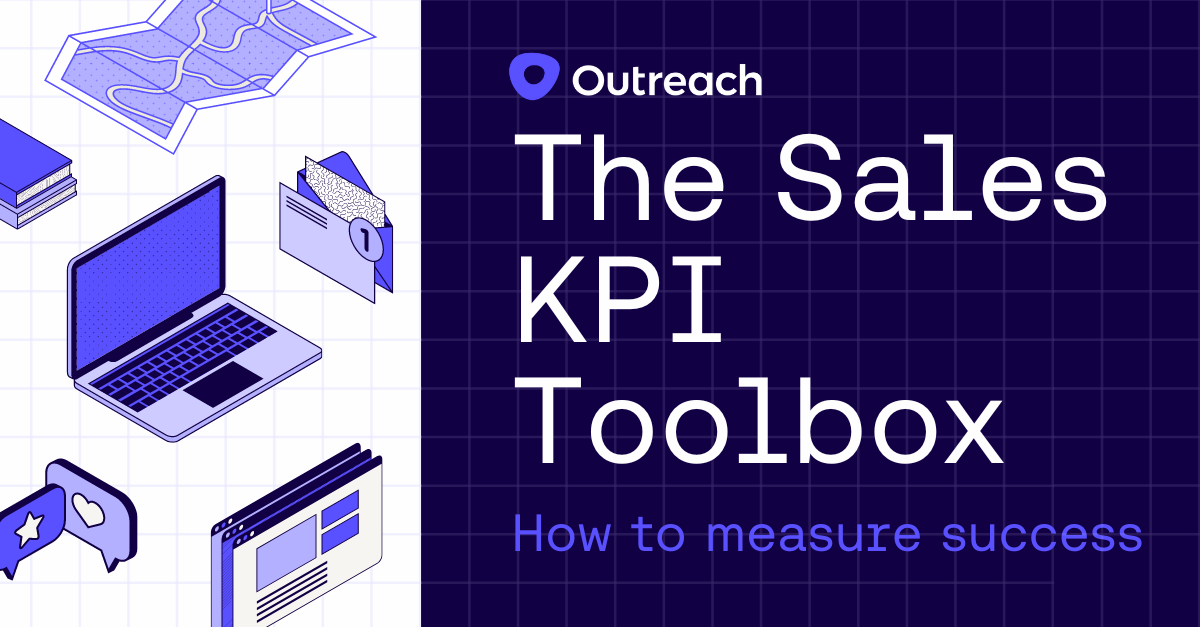
Outreach sales ROI calculator
What if every rep could sell like your best rep?
See the impact Outreach can have across your sales cycle. Using benchmark data collected from over 5,000 Outreach customers, we'll help you estimate the growth you could unlock across meetings, opportunities, pipeline, and revenue.

There's more to explore
Get a clear picture of why your sales and account management teams win, why they lose, and what they need to do to win consistently. We'll show you how.
What is sales ROI?
Sales ROI (Return on Investment) is a key performance metric that measures the profitability of sales activities relative to their costs. By comparing the net profit from sales to the total investment, revenue leaders get a better understanding into the overall efficiency of a business’s sales efforts. This calculation can help guide decision-making related to hiring, software spending, and additional resource allocation.
How does Outreach’s ROI calculator work?
The short answer: You input your current sales performance metrics, we apply improvement rates based on real customer data, and the calculator shows your potential results after using Outreach.
The long answer: Our ROI calculator leverages performance benchmarks based on conservative estimates of success our customers typically see across their sales cycle after implementing Outreach. Based on your inputs (number of reps, average deal size, monthly meetings and opportunities booked, and win rate), we apply the following benchmark improvement rates:
- 44% increase in meetings booked per month
- 20% increase in opportunities created per month
- 13% increase in average deal velocity (months from opportunity open to closed won)
- 15% increase in average deal size
- 10% increase in win rate
How accurate is Outreach’s sales ROI calculator?
Our performance benchmarks are derived from a sample of over 5,000 Outreach customers, ranging in size from 10 to 10,000 users across diverse industries, including financial services, technology, and manufacturing. All sampled customers have used the platform for at least 13–15 months.
While results vary from customer to customer, we've based our calculations on the improvement rate seen among the 25th percentile of customers — meaning 75% of our customers have seen even greater success. This approach, combined with an assumed 70% adoption rate, provides a conservative estimate of the success you might expect with Outreach.
What are the benefits of using Outreach's sales ROI calculator?
Before investing in new software, it's crucial to understand the potential return on investment. Our ROI calculator helps you build the beginnings of a business case for purchasing Outreach by estimating the value you could unlock from the platform.
If you’re interested in learning more, book time with our sales team to discuss the results and explore how Outreach can best serve your organization's specific needs.
How can I use the results?
The calculator offers a clear view of your current performance and potential improvements, so you and your team can identify where Outreach can make the biggest impact across your sales team.
Keep in mind that the ROI you get from Outreach will depend on your company size and industry, your current sales tech stack, and the exact needs of your team, so consider this number a ballpark number to get you started.
To get a more complete picture of what your Outreach ROI could look like, chat with our sales team about the pricing and packaging that makes sense for your organization. We’re happy to build a business case that addresses the biggest areas of improvement to your revenue growth.
FAQs about sales ROI
How do you calculate sales ROI?
Calculating sales ROI involves a straightforward formula:
ROI = (Net Profit from Sales - Investment Cost) / Investment Cost x 100
To calculate sales ROI:
- Determine your total sales revenue
- Subtract the cost of goods sold to get your gross profit
- Deduct all sales-related expenses (salaries, commissions, tools, etc.)
- Divide the result by your total investment cost
- Multiply by 100 to get the percentage
For example, if your sales team generated $500,000 in revenue with $300,000 in costs:
ROI = ($500,000 - $300,000) / $300,000 x 100 = 66.67%
This means for every dollar invested in sales, you're earning an additional $0.67.
Why is it important to track sales?
Effective sales tracking is essential for maximizing ROI and overall business performance. Teams should seek out a comprehensive sales execution platform that gives sales leaders visibility into their full sales funnel and surfaces actionable insights about reps, pipeline, and opportunities, so they have a clear picture of why they win, why they lose, and what to do to win consistently.
Tracking sales is crucial for several reasons:
- Performance evaluation: It allows businesses to assess the effectiveness of their sales strategies and individual salespeople's performance.
- Revenue forecasting: Accurate sales tracking helps in predicting future revenue, which is essential for budgeting and planning.
- Identifying trends: It helps in spotting patterns in customer behavior, seasonal fluctuations, and product popularity.
- Goal setting: Tracking sales provides a basis for setting realistic and data-driven sales targets.
- Decision making: It informs important business decisions such as inventory management, marketing strategies, and resource allocation.
- Customer insights: Sales data can reveal valuable information about customer preferences and buying habits.
- Competitive advantage: Thorough sales tracking can help identify areas for improvement and opportunities for growth, giving businesses an edge over competitors.
By investing in a robust sales tracking solution, companies can more accurately measure their ROI and make data-driven decisions to optimize their sales strategies.
What is a good ROI for a salesperson?
A good ROI for a salesperson typically ranges from 3:1 to 5:1, meaning for every dollar invested in the salesperson (including salary, commissions, and other costs), the company should expect to generate $3 to $5 in profit. However, this can vary widely depending on the industry, product complexity, sales cycle length, and company goals. Some organizations may consider a lower ROI acceptable for new markets or products, while others in established industries might expect higher returns.
This is where Outreach's sales platform becomes particularly valuable. By leveraging Outreach to design, measure, and execute key sales workflows, teams can significantly improve their efficiency and effectiveness. This increased productivity can lead to higher sales volumes and better conversion rates without necessarily increasing costs, potentially improving the ROI for each salesperson.
Is ROI the same as sales?
ROI is not the same as sales. Sales refer to the total revenue generated from selling products or services, while ROI measures the profitability of an investment relative to its cost.
This calculator can help you understand the additional growth you’ll see with Outreach across fundamental sales metrics such as meetings booked, opportunities created, pipeline generated, and revenue captured. To compare this total growth against your investment in Outreach, chat with our team. We’d be happy to help you compare Outreach’s pricing and packaging, so you have a full understanding of your return on investment.
What is a good ROI percentage?
A good ROI percentage will vary depending on the industry, risk level, and company goals. Generally, an ROI of 10% or higher is considered good, while an ROI of 20% or more is excellent. However, in some high-growth industries or for certain types of investments, companies might expect ROIs of 50%, 100%, or even higher. On the other hand, in more stable industries or for lower-risk investments, a lower ROI might be acceptable.
It's important to compare ROI to industry benchmarks and company-specific goals to determine what constitutes a "good" percentage for a particular situation. Continuously monitor the performance of your pipeline generation strategy. Analyze metrics such as website traffic, lead generation, and conversion rates. Then, make adjustments based on your data-driven insights.
Help your team reach their full potential
Together, we can build a sales process that is structured, aligned, and repeatable — all within Outreach.


